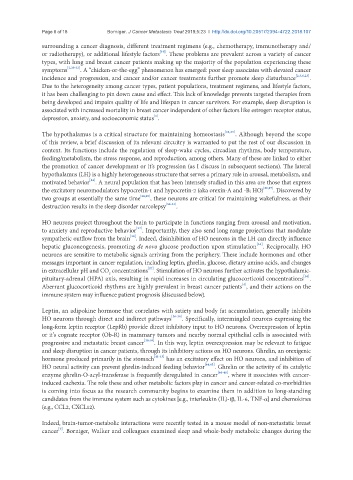Page 302 - Read Online
P. 302
Page 6 of 18 Borniger. J Cancer Metastasis Treat 2019;5:23 I http://dx.doi.org/10.20517/2394-4722.2018.107
surrounding a cancer diagnosis, different treatment regimens (e.g., chemotherapy, immunotherapy and/
[19]
or radiotherapy), or additional lifestyle factors . These problems are prevalent across a variety of cancer
types, with lung and breast cancer patients making up the majority of the population experiencing these
symptoms [2,20-22] . A “chicken-or-the-egg” phenomenon has emerged: poor sleep associates with elevated cancer
incidence and progression, and cancer and/or cancer treatments further promote sleep disturbance [2,3,6,23] .
Due to the heterogeneity among cancer types, patient populations, treatment regimens, and lifestyle factors,
it has been challenging to pin down cause and effect. This lack of knowledge prevents targeted therapies from
being developed and impairs quality of life and lifespan in cancer survivors. For example, sleep disruption is
associated with increased mortality in breast cancer independent of other factors like estrogen receptor status,
[3]
depression, anxiety, and socioeconomic status .
The hypothalamus is a critical structure for maintaining homeostasis [24,25] . Although beyond the scope
of this review, a brief discussion of its relevant circuitry is warranted to put the rest of our discussion in
context. Its functions include the regulation of sleep-wake cycles, circadian rhythms, body temperature,
feeding/metabolism, the stress response, and reproduction, among others. Many of these are linked to either
the promotion of cancer development or it’s progression (as I discuss in subsequent sections). The lateral
hypothalamus (LH) is a highly heterogeneous structure that serves a primary role in arousal, metabolism, and
[24]
motivated behavior . A neural population that has been intensely studied in this area are those that express
the excitatory neuromodulators hypocretin-1 and hypocretin-2 (aka orexin-A and -B; HO) [26,27] . Discovered by
two groups at essentially the same time [28,29] , these neurons are critical for maintaining wakefulness, as their
destruction results in the sleep disorder narcolepsy [30-33] .
HO neurons project throughout the brain to participate in functions ranging from arousal and motivation,
[27]
to anxiety and reproductive behavior . Importantly, they also send long range projections that modulate
[34]
sympathetic outflow from the brain . Indeed, disinhibition of HO neurons in the LH can directly influence
[35]
hepatic gluconeogenesis, promoting de novo glucose production upon stimulation . Reciprocally, HO
neurons are sensitive to metabolic signals arriving from the periphery. These include hormones and other
messages important in cancer regulation, including leptin, ghrelin, glucose, dietary amino acids, and changes
[27]
in extracellular pH and CO concentrations . Stimulation of HO neurons further activates the hypothalamic-
2
[36]
pituitary-adrenal (HPA) axis, resulting in rapid increases in circulating glucocorticoid concentrations .
[4]
Aberrant glucocorticoid rhythms are highly prevalent in breast cancer patients , and their actions on the
immune system may influence patient prognosis (discussed below).
Leptin, an adipokine hormone that correlates with satiety and body fat accumulation, generally inhibits
HO neurons through direct and indirect pathways [36-38] . Specifically, intermingled neurons expressing the
long-form leptin receptor (LepRb) provide direct inhibitory input to HO neurons. Overexpression of leptin
or it’s cognate receptor (Ob-R) in mammary tumors and nearby normal epithelial cells is associated with
progressive and metastatic breast cancer [39,40] . In this way, leptin overexpression may be relevant to fatigue
and sleep disruption in cancer patients, through its inhibitory actions on HO neurons. Ghrelin, an orexigenic
hormone produced primarily in the stomach [41-43] has an excitatory effect on HO neurons, and inhibition of
HO neural activity can prevent ghrelin-induced feeding behavior [44,45] . Ghrelin or the activity of its catalytic
enzyme ghrelin-O-acyl-transferase is frequently deregulated in cancer [46-48] , where it associates with cancer-
induced cachexia. The role these and other metabolic factors play in cancer and cancer-related co-morbidities
is coming into focus as the research community begins to examine them in addition to long-standing
candidates from the immune system such as cytokines [e.g., interleukin (IL)-1β, IL-6, TNF-α] and chemokines
(e.g., CCL2, CXCL12).
Indeed, brain-tumor-metabolic interactions were recently tested in a mouse model of non-metastatic breast
[6]
cancer . Borniger, Walker and colleagues examined sleep and whole-body metabolic changes during the

